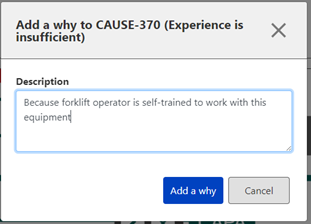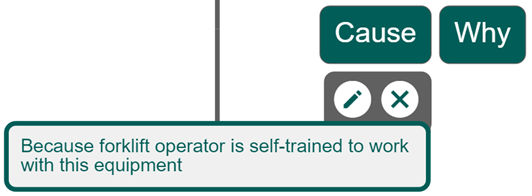How to arrange 5Why analysis?
How to go to 5 Why analysis from the fishbone schematic?
 Similar questions: How to build a 5 Why tree for analysis?
Similar questions: How to build a 5 Why tree for analysis?
5Why method allows to analyze facts or causes related to them in order to
search for one or several Root Causes or Immediate Causes according to the list
of Causes used by the company (presented in drop-down lists in CONFORMiT
software). There may be less than 5 or more than 5 answers to questions “Why
was this true?” aiming to respond a fact category or a cause related to it.
Answers are becoming questions for next “Why?” in this analysis method until conclusion
that received points directly towards the Root Cause or Immediate Cause. CAPAs
are being developed for discovered Causes to reduce chances of recurrence of similar
incidents.
- Within
module Analysis section on the fishbone schematic find the fact category, Immediate Cause or a Root Cause that you wish to analyze using 5 Why method and place your cursor on it on the schematic.
- Two buttons will appear above the box (Edit and
Add) buttons. Click on
and select “Why” option and fill up the description by answering to question “Why this cause (or this fact) happened?”
· 


- New analysis tree will appear to the right side from the fishbone where we can give an answer by our answer and so on until we reach the Root Cause or Immediate Cause (primary goal is to find the Root Cause as most important key to understanding why the incident happened)
- If we put our cursor on our question-answer that we wish
to analyze further and press on
-- we get to choose either to proceed with 5Why analysis or to link a cause to this item
· 
- Since our answer is obviously not pointing to the
Cause yet, we continue with 5Why analysis
- When answer allows us to respond with one of Root
Causes or Immediate Causes from the list – that means we found the Cause nature,
therefore we select to add it
·
- From the Root Cause we may proceed to looking for more
Causes using 5Why method, or we can add more causes if they come evidently from
the one we just discovered. As well as we can go to CAPA window to create a corrective
measure (it is recommended to create at least 1 CAPA for each Root Cause that
was discovered to eliminate the hazard in the future)
Related Articles
Elements of the fishbone schematic for Analysis stage.
Elements of the fishbone schematic for Analysis stage. Similar questions: What is depicted on the fishbone in Analysis section? Within module find in the list event that you need to update and click on ID number (for example ) to open the ...Setting up the Risk Matrix
How to set up the risk matrix field? Similar questions: Where to arrange the risk matrix? In order to change or set up the risk matrix user needs relevant rights within his/her Role in the tenant of CONFORMiT software. Refer to your administrator ...Creating new Risk from Event details or linking an event to the existing Risk
Similar questions: How to create a Risk Analysis from the Event details page? How to link an existing Risk Analysis to the Event from Web interface events details page? Creating a new Risk or linking the existing one is possible for tenants that have ...How to determine the initial risk?
How to determine initial risk? Similar questions: How to calculate initial risk associated with the event? An event that happened or could’ve happened (for near misses) is taken into consideration itself when analysing factors of the risk matrix. ...Features for quickly consulting description of facts and causes on the fishbone and 5Why schematic.
How to quickly consult description of the fact or cause on the fishbone or 5Why? Similar questions: Where to view fact or cause instead of the category in Analysis section? Features for quick view of the description and linked corrective measures ...